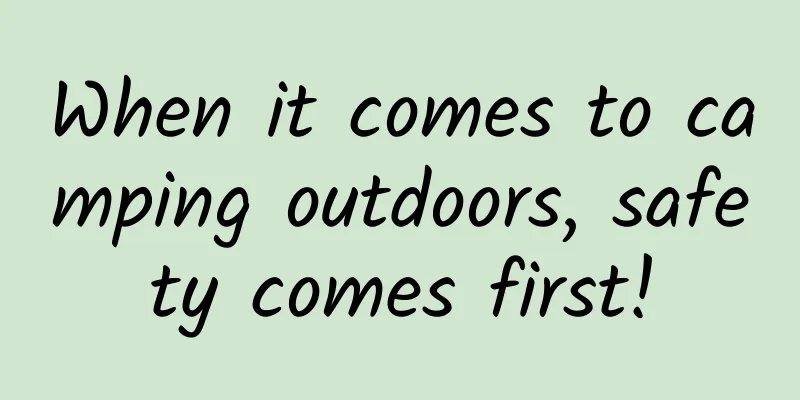When it comes to camping outdoors, safety comes first!

|
As the weather clears up and the flower viewing season arrives, we can always see a lot of campers enjoying outdoor life on the lawns of parks and by the artificial lakes every weekend. In the minds of most young people, the only difficulty in camping is probably how to set up the tent. Well, yes, setting up a tent is something worth considering, and the first thing is the location. Image source: soogif #1 Camping base? Convenient and worry-free A tent sets up poetry and the distance. Nowadays, camping is popular, and many camping bases have sprung up around cities, with all kinds of living and recreational facilities, which are very convenient. This type of camping base is relatively mature and will also be recommended by netizens. Therefore, before traveling, you can check and choose the camping environment you like. After arriving at the destination, you should choose a hard and flat ground, on which the tent will be more solid and comfortable. If you don't grab a precious seat in these mature camping bases, or prefer a quiet and sparsely populated wild camping site, please remember to choose a place close to the village and human habitation, so that you can seek help smoothly in case of an emergency. Image source: contracted photographer/IC photo Mountain areas? A sleeping bag is a must If you need to go into the mountains, please note that the temperature usually drops by 0.6 degrees Celsius for every 100 meters of altitude increase. Even in hot low-altitude areas, high-altitude mountainous areas (relative height difference with the surrounding area is more than 1000-2000 meters) may still have low temperatures that are harmful to the human body. Therefore, sleeping bags are essential for camping. When the temperature may drop to zero degrees at night, you should prepare a sleeping bag, which is more effective in keeping warm than sleeping in clothes or covering yourself with a blanket. In addition, you should try to avoid wind vents (such as passes between peaks, deep canyons without obstacles, etc.), after all, strong winds may cause rapid hypothermia. Image source: Paixin Creative #3 No man's land? NO! Although camping in sparsely populated areas may seem romantic, in fact, it is a potentially dangerous behavior to enter uninhabited areas, especially unexplored, complex mountainous areas or vast Gobi wilderness. Here, most modern communication tools (satellite phones are better) are at risk of failure, and once the means of contact with the outside world are lost, it means that it will be much more difficult to call for help in distress. Therefore, unless you are a professional adventurer or someone with special work needs, you should not hike for a long time or risk camping in areas with poor external communication. Image source: Paixin Creative #4 Waterside? Try not to Although camping near water seems to be a good idea, it is not only convenient for getting water, but also allows fishing and playing in the water. But please try not to do this, because: stagnant and lacking fluidity of muddy water is often turbid in color and contains many pathogenic microorganisms; and the higher the water temperature (except for hot springs), the more "rich and colorful" the organisms contained in the water body are, and even the fish and shrimp caught from it may be at risk of parasites and pathogenic microorganisms. On the contrary, transparent, cold mountain spring water and stream water are much safer, especially the water that has been repeatedly filtered through soil and rock layers and just flowed out of the spring. In addition, after the excavation of some open-pit mining areas, huge pits may be left to form lakes or ponds. This water body may seem clear, but there may be hidden dangers of heavy metal and harmful non-metallic chemical pollution. Image source: Paixin Creative #5 Mountain stream? Try to avoid it When camping near mountain streams or creeks with large elevation differences, you must always be aware of the possibility of flash floods. Therefore, it is necessary to check the surrounding weather records and determine whether there has been precipitation nearby before camping. If there has been large-scale continuous precipitation in the upstream area, or there are signs of flash floods near the camping site (soil, vegetation debris and debris washed away by water, and signs of flooding), you should avoid camping near the water. In addition, if the river water suddenly becomes turbid and floating objects appear, it means that a flash flood is coming and you should evacuate before the water level rises. Image source: Paixin Creative #6 Cave? There are safety hazards If you find a cave in the wild, don't rush into it to camp. First of all, you are not the only one who likes to live in caves. Some dangerous large wild animals also use caves as their homes, especially when the temperature is low. Secondly, compared with the uncommon wolves, bears and bears nowadays, the more dangerous animals are actually the Chiroptera (such as bats) and some rodents that live in caves. Contact with these guys may infect you with dangerous unknown pathogens, or pick up troublesome parasites such as chiggers and ticks. In addition, in places with unstable geological conditions, caves also have the risk of landslides. Image source: Paixin Creative Notice It is important to pay attention to the weather forecast before entering the mountains, but this alone is not a panacea: in mountainous areas with complex terrain and large height differences, canyons, steep cliffs and small basins, uneven surface heating often produces turbulent airflow, resulting in local fog, strong winds and cooling, which are difficult to predict. Therefore, when camping in the mountains, it is best to prepare warm clothes and insulation blankets and other supplies, and always be alert to weather changes around you, which can increase the safety factor to a certain extent. Image source: Paixin Creative In short, when camping in the wild, "cowardice" can better ensure your safety than "bravery": if you are not a professional field worker or explorer, then remember that the closer your camping spot is to the park lawn in the city, the higher your safety factor will be, and safety always comes first. Source: Chongqing Science and Technology Museum About the author: Sokhov is a popular science and science fiction writer who won the silver medal for novellas at the China Science Fiction Nebula Award. Statement: Except for original content and special notes, some pictures are from the Internet. They are not for commercial purposes and are only used as popular science materials. The copyright belongs to the original authors. If there is any infringement, please contact us to delete them. |
>>: Is alcohol a screen killer? Countless mobile phones have been killed!
Recommend
How much does a four-day tour to Hong Kong and Macau cost?
If you travel independently, all the expenses wil...
Customized birthday blessing video for foreign beauties
I believe everyone hopes to receive video birthda...
Weathered and in a tough situation, this tree is facing the risk of extinction
When it comes to maple trees, you may be very unf...
Top 10 basic algorithms used by programmers
[[188736]] Algorithm 1: Quick sort algorithm Quic...
Why do chubby bees make their nests in the shape of a regular hexagon?
Produced by: Science Popularization China Author:...
Application of face stylization technology on mobile terminals
Preface With the explosion of concepts such as th...
Thoughts on creating popular e-commerce products
In June 2020, I came to Shenzhen and started to b...
The Astronomical Mystery of "Five Stars Rising from the East Bring Good Luck to China"
Produced by: Science Popularization China Author:...
Osteoporosis is caused by sun protection? Causes of osteoporosis for office workers +1
Audit expert: Zhang Yuhong Chief Physician of Der...
Safety of GM's 'Super Cruise' semi-autonomous driving system questioned
According to Reuters, the U.S. Highway Traffic Sa...
Tik Tok operation skills in the catering industry!
1. Current market situation of catering industry ...
How much does it cost to be an agent of Bozhou Tattoo and Embroidery Mini Program? What is the price of being an agent for Bozhou Tattoo and Embroidery Mini Program?
How much does it cost to be an agent for a tattoo...
How much does it cost to develop a Harbin nail art mini program? How much is the price for developing a Harbin nail art mini program?
How much is the price for developing a Harbin nai...
Ruan Yifeng: Introduction to Monte Carlo Method
1. Overview The Monte Carlo method is a calculati...
How big is an ant hole? People poured cement into the ant hole, but it was still not full after pouring 10 tons...
When you see some ants and small ant holes on the...









